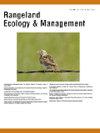Postfire Seeding of Native Compared With Introduced Bunchgrasses Followed 3 Yr Later With Invasive Annual Grass Control
IF 2.4
3区 环境科学与生态学
Q2 ECOLOGY
引用次数: 0
Abstract
Invasive annual grasses threaten the ecological integrity of the sagebrush ecosystem, often increasing when wildfires or other disturbances reduce perennial vegetation. In response to this threat, perennial bunchgrasses are often seeded after wildfire. Because of greater success in establishment, introduced bunchgrasses are often selected for seeding instead of commercially available native bunchgrasses. However, locally sourced native bunchgrasses appear to establish better than generally expected for commercially available native bunchgrasses but introduced bunchgrasses still establish better and result in greater suppression of invasive annual grasses. In areas where native bunchgrasses have been established from seeding but annual grass abundance remains high, selective control of annual grasses may improve success. Comparisons between areas where locally sourced native and introduced bunchgrasses were seeded and established, followed by annual grass control, are lacking. We investigated vegetation characteristics in areas drill-seeded with introduced compared with locally sourced native bunchgrasses after a wildfire that received selective annual grass control (imazapic application) 3 yr after seeding. Treatments that were seeded with locally sourced native or introduced bunchgrasses followed by spraying imazapic increased bunchgrass cover and density compared with areas not seeded but sprayed with imazapic. Bunchgrass cover and density were greater in areas seeded with introduced compared with native bunchgrasses and sprayed with imazapic. Invasive annual grass abundance was reduced with seeding introduced bunchgrasses followed with imazapic application, but not with seeding locally sourced native bunchgrasses followed with spraying imazapic. These results suggest that locally sourced native bunchgrasses have the potential for restoration success, but research needs to determine what follow-up treatments (e.g., additional seeding, longer-term annual grass control, and more diverse seed mixes) are needed to further promote perennial vegetation abundance and increase resistance to annual grasses to achieve similar outcomes as seeding introduced bunchgrasses.
火后播种与引种禾本科禾本科3年后与入侵禾本科防治的比较
入侵的一年生草威胁着山艾属植物生态系统的生态完整性,当野火或其他干扰减少多年生植被时,这种威胁往往会增加。为了应对这种威胁,多年生束草经常在野火后播种。由于在种植上取得了更大的成功,通常选择引进的束草而不是市售的本地束草进行播种。然而,本地采购的本土束草似乎比一般预期的更好,但引进的束草仍然更好地建立,并对入侵的一年生草产生更大的抑制。在从播种开始就建立了本地束草,但一年生草丰度仍然很高的地区,选择性控制一年生草可能会提高成功率。缺乏对从当地采购的本地禾草和引进的禾草进行播种和种植,然后每年进行禾草控制的地区进行比较。我们研究了在野火发生后,在播种3年后进行选择性年度控草(imazapic施用)的地区,与引进的钻孔播种地区的植被特征进行了比较。与未播种但喷洒异氮吡嗪的地区相比,播种本地或引进的禾草后喷洒异氮吡嗪的处理增加了禾草的盖度和密度。引种灌种区束草的盖度和密度均高于本地束草灌种区。播种引种禾草后施用异氮吡嗪可降低入侵禾草年丰度,而播种本地禾草后施用异氮吡嗪则不会降低入侵禾草年丰度。这些结果表明,本地种植的束草具有恢复成功的潜力,但需要研究确定需要什么样的后续处理(例如,额外播种、长期的一年生草控制和更多样化的种子混合)来进一步促进多年生植被丰富度,增加对一年生草的抗性,以达到与播种引入束草相似的结果。
本文章由计算机程序翻译,如有差异,请以英文原文为准。
求助全文
约1分钟内获得全文
求助全文
来源期刊

Rangeland Ecology & Management
农林科学-环境科学
CiteScore
4.60
自引率
13.00%
发文量
87
审稿时长
12-24 weeks
期刊介绍:
Rangeland Ecology & Management publishes all topics-including ecology, management, socioeconomic and policy-pertaining to global rangelands. The journal''s mission is to inform academics, ecosystem managers and policy makers of science-based information to promote sound rangeland stewardship. Author submissions are published in five manuscript categories: original research papers, high-profile forum topics, concept syntheses, as well as research and technical notes.
Rangelands represent approximately 50% of the Earth''s land area and provision multiple ecosystem services for large human populations. This expansive and diverse land area functions as coupled human-ecological systems. Knowledge of both social and biophysical system components and their interactions represent the foundation for informed rangeland stewardship. Rangeland Ecology & Management uniquely integrates information from multiple system components to address current and pending challenges confronting global rangelands.
 求助内容:
求助内容: 应助结果提醒方式:
应助结果提醒方式:


